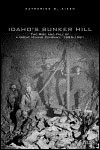book
Idaho's Bunker Hill: The Rise and Fall of a Great Mining Company, 1885
by Katherine G. Aiken ('80 Ph.D. Hist.) :: University of Oklahoma Press :: Reviewed by Keith Petersen '73

Bunker Hill finally has a book worthy of its story. BH, during its heyday, was one of the nation's most important mining and smelting operations, and wielded unprecedented influence over Idaho politics. At the time it closed in 1981 it produced 15 percent of America's silver and zinc, and 17 percent of its lead. Much has been written about BH. But this is the first book to encapsulate its entire history, from lode discovery to company closure.
Aiken weaves together many stories. Hers is one of the best tellings of the oft-romanticized origins of the mine that Noah Kellogg's donkey might or might not have discovered. She deftly handles the long and often violent history of labor strife. She notes the company's impact, positive and negative, upon the community of Kellogg. She provides detailed biographical sketches of various corporate leaders who guided the company's fate. Her graphic descriptions of mining accidents can make a reader cringe.
Perhaps Aiken's greatest contribution, however, is her careful recording of the company's environmental history. As much as anything, it was Bunker Hill's—and its corporate buyout successor, Gulf Resources and Chemical Corporation's—lack of responsiveness to a growing environmental disaster that forced closure. This lack of responsiveness was a tired, repetitive tale by 1981.
As early as 1899 farmers complained that mining and milling wastes damaged their crops and livestock. Well aware of studies that showed a smelter in Kellogg would produce unhealthy lead emissions, BH nonetheless commenced smelter operations in 1917. It knew workers inside the smelter would suffer even more than residents outside. Whoever worked in the smelter "may become leaded," wrote a visiting surgeon in 1918. In 1935, one BH worker, noting that all the trees around Kellogg were dead or dying, stated, "The only thing that grows here is the undertaker's business and the graveyard."
BH's response to environmental criticism throughout its history remained essentially the same: utilize corporate deep pockets to outlast claimants bringing civil suits; crank up the public relations machine; and toss out a few dollars and a few pabulums to convince people that the company cared about worker safety and possessed an environmental consciousness.
Only with the growth of state and federal environmental regulations in the 1970s, and the full strength of government enforcement capabilities, did the company finally run out of options. Its years of corporate profit-taking at the expense of environmental cleanup proved to be the leading reason for the company's failure. Gulf Resources, after moving its assets overseas, declared bankruptcy, leaving taxpayers to foot the bill for one of the nation's largest Superfund sites.
Today, many in Kellogg blame government regulators, not corporate managers, for the company's demise. But this book sets the true, and complicated, record straight. It is an admirable effort, painstakingly researched, and engagingly written.